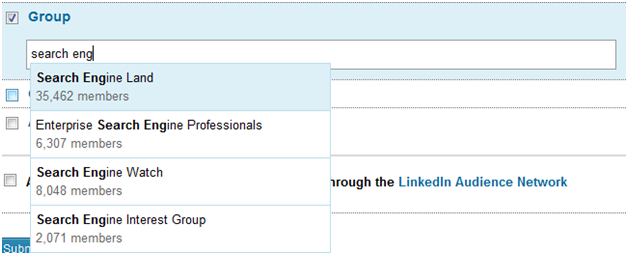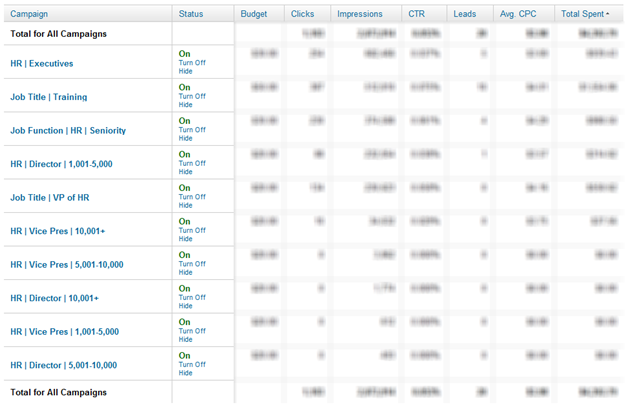I covered the basics of LinkedIn advertising in a post on the KISSmetrics blog a few months back. Now, I’m going to touch on more advanced strategies for structuring your campaigns, writing your ads and stretching your LinkedIn ad dollars.
Are you ready to try out some expert tips and get clever about your LinkedIn PPC campaigns? Good.
Writing the perfect ad copy for LinkedIn
Take a look at the pair of ads below. TheseRead more…
Read more...I covered the basics of LinkedIn advertising in a post on the KISSmetrics blog a few months back. Now, I’m going to touch on more advanced strategies for structuring your campaigns, writing your ads and stretching your LinkedIn ad dollars.
Are you ready to try out some expert tips and get clever about your LinkedIn PPC campaigns? Good.
Writing the perfect ad copy for LinkedIn
Take a look at the pair of ads below. These showed up on my LinkedIn homepage the other day. What do you notice about them?
If you said that they both call out their target audience in the headline explicitly by title, you’re right.
Try an ad variation using your target audience’s job title in the headline (e.g. Sales Executive). This strategy is likely to improve your clickthrough rate, and in turn, conversions, while decreasing irrelevant clicks.
Now, have a look at these two ads. Why is the ad on the left more effective?
Nice, large photo of a person’s face. In most cases, you’ll get a better clickthrough rate if your photo is of a person’s face, clearly visible. Your company’s logo is not as effective in this context as a live human being. Of course, you don’t have to use a photo of a person if it’s more relevant to depict something that your target audience will immediately relate with. If you’re selling software that helps beef up Excel for superusers, a “supercharged Excel logo” might be even better.
Strong call to action. The ad on the left encourages you to “Get a free quote” – the ad on the right leaves you hanging.
Punctuation. Using clean punctuation and terse, natural-sounding phrases is best. Although this particular example doesn’t capitalize the first letter of every word, excluding articles and prepositions, this is also an AdWords ad copy best practice that translates nicely.
Relevant headline. Needless to say, using your company name in the headline is not effective. Speaking to your audience and clearly laying out your product or service offering is how you want to spend your 25 characters.
Contrary to the best practices cited by LinkedIn, their customer success team has recommended running just 2 ads at a time per campaign. If you only have 2 ads active within a campaign, the system can quickly determine which ad is the best and show that ad more often. Once you know this information, you can turn off the second ad and replace that ad with a new ad variation. Then you simply rinse, lather and repeat.
Be sure to have a free offer that’s targeted and compelling. Give away something for free, whether it’s written content, promotional items or a seat in a webinar – you’ll see a healthier response, guaranteed.
Try using a “use by” date in your ad copy to create urgency. What’s true in mass email subject line testing also works for LinkedIn ad copy: if the ad is explicit that your giveaway has a limited supply, or ends by a specific day, your clickthrough rate will almost certainly improve.
Switch up your ads often, at least once a month. New ads get a boost in terms of impressions and have a chance of scoring a higher CTR than your previous ads. Although LinkedIn claims a good solid clickthrough rate to be 0.025%, you can do better with laser-targeted ads featuring compelling copy.
Finally, don’t overlook that you can target members of particular LinkedIn Groups, similar to the way you can target Facebook ads at users who “like” the page of a company or cause. Peruse the groups directory and find cohorts that could be relevant to what you’re slingin’. Then, write ads that speak to those group members.
Smart campaign structure
It’s tempting (and intuitive) to create one campaign targeting your audience, plug in some ads and let ‘er rip. But according to the optimization ninjas at LinkedIn, you’ll actually get more impressions if you segment your campaigns by the types of titles you’re targeting, the company size you’re going after, etc.
In the example below, check out how every demographic sliver has its own campaign. Professionals with a specific job title, e.g. VP of HR, have a single dedicated campaign, as do those with a job function in HR and relatively senior titles, perhaps director-level and above.
If you choose to target by job function (e.g. Accounting), run just one Job Function for each new campaign.
Remarketing & LinkedIn Ads can play together
If you’re retargeting your site visitors with ads while they browse the web elsewhere, you should recognize your LinkedIn campaigns represent an opportunity to build up a laser-targeted remarketing pool! For example, target only Chief Legal Officers at large corporations with a specific offer and landing page. With remarketing code on that page, build up your tailored creative and remarket specifically to that pool of CLOs. Even if they don’t convert on the landing page, you get nearly-free brand exposure down the road.
If you create a dedicated landing page for the CLO-focused ads you’re running on LinkedIn, you can consequently tailor your display advertising message via retargeting only to that particular pool. Your remarketing tags on the rest of your site can be different from those you place on this LinkedIn-specific landing page.
Don’t forget, if you’re crafty, you can grab a $50 LinkedIn Ads gift card. Reach out to an online marketing firm you’re chummy with, or try to hit up the LinkedIn team.
Ultimately, testing and playing around with different offers and targeting options will lead you to discover your own expert tips and strategies. These tips are a good place to start optimizing your campaigns, and once you’ve had a chance to toy with them, we’d love your comments on what worked and what didn’t.
...Read less



